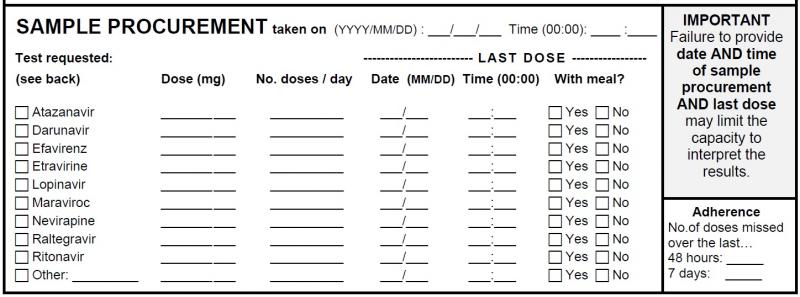[collapsed][collapse title="Patient identification" collapsed="collapsed"]  We ask that you provide the patient identification information at the top right of the form (patient name, medical record number, date of birth, gender, health insurance number). This information is required for identification of the report that will be sent to the physician. The age of the patient will allow individualization of the interpretation, particularly in paediatrics. All information will remain confidential and will only be consulted by the personnel of the Québec Antiretroviral Therapeutic Drug Monitoring Program. [/collapsed]
We ask that you provide the patient identification information at the top right of the form (patient name, medical record number, date of birth, gender, health insurance number). This information is required for identification of the report that will be sent to the physician. The age of the patient will allow individualization of the interpretation, particularly in paediatrics. All information will remain confidential and will only be consulted by the personnel of the Québec Antiretroviral Therapeutic Drug Monitoring Program. [/collapsed]
[collapsed][collapse title="Physician identification" collapsed="collapsed"] Complete mailing address for sending the interpretation report is necessary. Also, phone and fax numbers for crucial value reporting are essential. For administrative and legal reasons, the license number of the treating physician must be completed. [/collapsed]
[collapsed][collapse title="Patient information" collapsed="collapsed"] 
Weight/height: Low body weight and obesity may potentially influence antiretroviral concentrations. Calculation of the body surface area is also essential in paediatrics.
Pregnancy: Gestational age, when applicable, is of extreme importance as the pharmacokinetics of the antiretroviral may vary according to the trimester of the pregnancy.
Race: Patients of different ethnic backgrounds may metabolize drugs at different rates. This could be explained by genetic polymorphisms of certain metabolic enzymes which can contribute to large interpatient pharmacokinetic variability of antiretrovirals.
Indication: The pharmacological advice may be influenced by the reason for which the TDM was requested.
All current medications: We require a list of prescribed medications, over the counter medications and natural health products taken by the patient. Possible interactions will be analyzed and taken into consideration in the interpretation and pharmacological advice provided. [/collapsed]
[collapsed][collapse title="History of virologic failure, resistance and adherence information" collapsed="collapsed"] 
Previous virologic failure: The target values for patients with prior virologic failure to one or different classes of antiretrovirals may be higher in comparison to those without prior failure.
Cumulative list of mutations: The resistance data is incorporated into the interpretation of drug concentrations by means of the genotypic inhibitory quotient (GIQ) and virtual inhibitory quotient (vIQ). The physician may either transcribe the cumulative mutation list or fax a copy of all the genotypes done for a given patient.
IC50 fold-change: It is recommended to transcribe the fold-change of darunavir or etravirine if a virtual phenotype is available. If several virtual phentypes were done, please fax a copy of all results for a more accurate interpretation. [/collapsed]
[collapsed][collapse title="Procurement and dosing information" collapsed="collapsed"] 
Procurement, date and time of last intake: The time and date of sample procurement and of the last dose intake is of paramount importance as plasma concentrations vary according to the time elapsed between the last dose and the procurement time. The same concentration could be supratherapeutic, therapeutic or subtherapeutic depending on when the procurement time was in relation to the last dose.
Antiretroviral(s) to analyze: The antiretroviral(s) to be analyzed must be checked off to receive a report. Note that you will not be charged for ritonavir TDM when it is accompanying a protease inhibitor as a pharmacoenhancer. Furthermore, you will not receive an interpretation report specifically for ritonavir. It is however important to provide the dose and number of doses per day of ritonavir as this may influence the pharmacokinetics of the active protease inhibitor.
Dose, # of doses/day: The concentrations of a drug will vary according to the dosing regimen. Also, dosing recommendations are made according to the patient’s current dosing regimen.
Intake with meal: The intake with or without food may greatly influence the absorption of certain antiretrovirals. This is also taken into account when making recommendations.
Antiretroviral adherence: The number of doses missed over the last week may influence the plasma concentration of the analyzed drug and must be taken into consideration in the interpretation of the result. [/collapsed]
